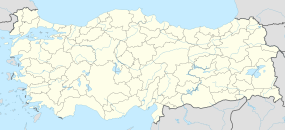Schifout Kassaba

1st/2nd century AD Roman statue of Dionysus from Synnada
|
|
| Coordinates | 38°32′N 30°33′E / 38.533°N 30.550°ECoordinates: 38°32′N 30°33′E / 38.533°N 30.550°E |
|---|---|
Synnada (Greek: Σύνναδα) was an ancient town of Phrygia Salutaris in Asia Minor. Its site is now occupied by the modern Turkish town of Şuhut, in Afyonkarahisar Province.
Synnada was situated in the south-eastern part of eastern Phrygia, or Parorea, thus named because it extended to the foot of the mountains of Pisidia, at the extremity of a plain about 60 stadia in length, and covered with olive plantations.
Synnada is said to have been founded by Acamas who went to Phrygia after the Trojan war and took some Macedonian colonists. It enters written history when the Roman consul Gnaeus Manlius Vulso passed through that city on his expeditions against the Galatians (189 BCE). After having belonged to the kingdom of the Attalids, it became the capital of a district of the province of Asia, except on two occasions during the last century of the Roman Republic when it was temporarily attached to Cilicia. Under Diocletian at the time of the creation of Phrygia Pacatiana, Synnada, at the intersection of two great roads, became the metropolis (capital). In Strabo's time it was still a small town, but when Pliny wrote it was an important place, being the conventus juridicus for the whole of the surrounding country.Cicero mentions that he passed through Synnada on his way from Ephesus to Cilicia. The city was celebrated throughout the Roman Empire on account of the trade in a beautiful kind of marble, which came from nearby quarries and was commonly called Synnadic marble, though it came properly from a place in the neighborhood, Docimia, whence it was more correctly called Docimites lapis. This marble was of a light color, interspersed with purple spots and veins. Under Diocletian at the time of the creation of Phrygia Pacatiana, Synnada, at the intersection of two great roads, became the metropolis (capital). On its coins, which disappear after the reign of Gallienus, its inhabitants call themselves Dorians and Ionians. Under Ottoman rule it became the city of Schifout Kassaba, situated five hours south of Afyonkarahisar, in the vilayet of Broussa.
...
Wikipedia

